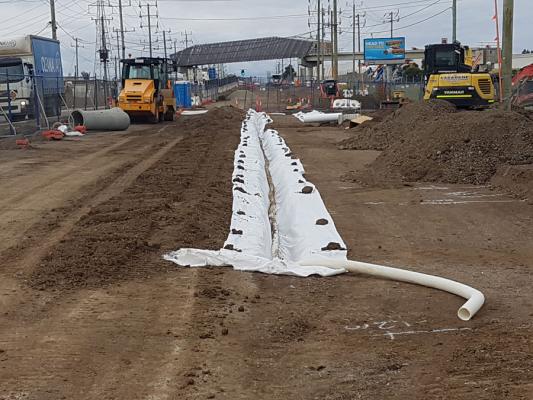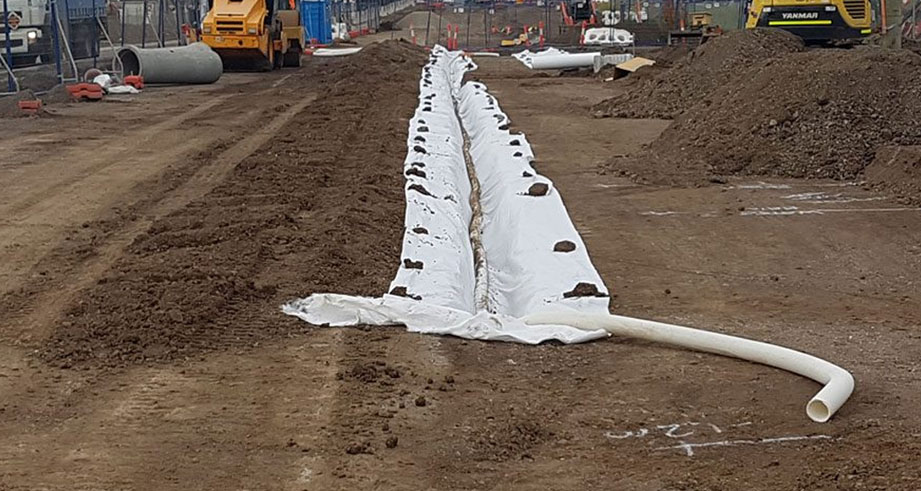How to install an ag pipe

How to install an ag pipe and set your project up for success
Buildings cannot exist without solid foundations and a solid foundation begins with the right drainage. To install good drainage, you need to understand the nature of the water flow on your property.
Surface water is sometimes easier to collect and divert rather than using a subsoil drain, yet there are times when subsoil agricultural drains are required. If incorrectly installed, agricultural pipe drainage systems may exacerbate the problem of waterlogged foundations rather than providing the solution.
That being the case, construction on clay and developments in recent years which use smaller land titles and build to boundary edges mean that it is important to know the benefits of agricultural pipes and how to install them.
What is an ag pipe?
Agricultural pipes - also called ag pipes, soakage drains, agi pipes, ag lines, slotted drainage pipes or french drains - are underground plastic pipes that help prevent damage to buildings by removing water from the soil.
When to install ag pipes
Ag pipes should be used only in situations when excess water is already in the ground and cannot be avoided.
Some property owners do not have control over the ground level and surface water of adjoining properties, or properties may be adjacent to deep footings or basements. Ag pipes will also be needed in situations when water is running through the ground above a property, when water is behind a retaining wall, or when earthworks are required to make the ground more level.
How ag pipes work
Ag pipes improve subsoil drainage by removing excess water to help prevent slab heave and structural cracking. White slotted UPVC pipes or black slotted and corrugated UPVC pipes are laid in a trench which is then re-filled with gravel.
Water is directed by the gravel to the pipe and then drained away. The pipe can also be fitted with a type of sock called a geofabric filter that may help prevent pipe-blockages, but some people find these to be more of a hindrance than a help.
Blocked pipes that are unable to drain water away from a property can create waterlogged soil instead of reducing moisture, so it is important that ag pipes are installed correctly.

How to install an ag pipe
Black or white corrugated pipe with lateral slots is commonly used for domestic purposes.
- When laying the pipe, ensure the pipe and the bottom of the trench are on a slope in the direction of the existing water flow, moving with gravity. It is best if the gradient is 1 centimetre to half a metre (1 in 50), although a gradient of 1 centimetre to 1 metre (1in 100) will still work.
- The trench for the pipe must be twice the width of the pipe and 25 millimetres deeper than the level of the pipe. Gravel should be laid 25mm in the trench while keeping the gradient.
- Keep the pipe straight when laying it along the gravel. Using 10mm gravel will avoid the need for a geofabric sock.
- Fill the trench with the gravel almost to the top, and then fill the remaining 100mm with topsoil until the trench becomes level with the ground.
Things to consider when you install your agg pipe
Separate systems
To avoid waterlogged soil, separate pipe systems must be used. Connecting ag pipes to roof downpipes or stormwater pipes is a mistake, as water can easily flood through the ag pipe and flow back into the trench, ultimately weakening the building.
For this reason, it is also important never to run ag pipes under the building itself, due to the slots in the pipe, and pipes should be at least 1 metre away from the foundations.
While solid pipes can be installed under a house, it is best to take water away from the area altogether. Collecting stormwater as it falls in a concrete surface-level spoon drain may be an option in some circumstances.
Ag pipes should not be connected to the stormwater system, however, the lower end of the ag pipe can be discharged into the stormwater if the stormwater is downhill from the building. The end of the ag pipe should finish at the soil's surface so it can be flushed for easy maintenance. Make sure there is a cap on the end to prevent debris from entering the pipe.
Silt pits
Silt is another factor to be considered. National industry construction codes may require silt traps to be constructed and regularly cleared. The base of the pit must be below the inlet and outlet pipes so that any silt in the drain will be trapped in the pit. Silt must be removed manually from the pit to prevent blockage.
Keeping water away from your building by purchasing the correct materials for installing an ag pipe is a practical way of maintaining the structural integrity and value of your property.
Find out more about how to install drainage pipes or buy agg pipe online at Jaybro.
 Sign In
Sign In 

